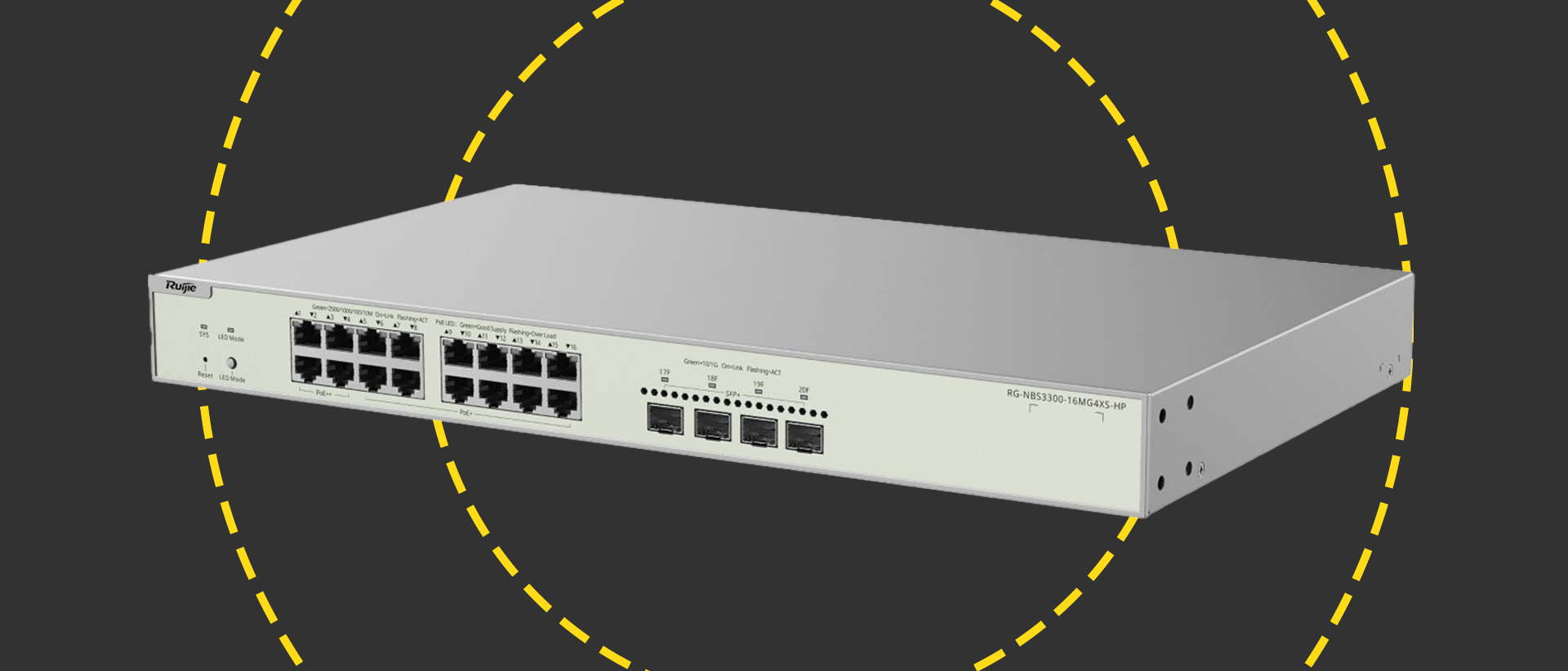Ruijie Reyee RG-NBS3300-16MG4XS-HP review: A well-endowed PoE switch at a good price
Ideal for budget-conscious SMBs, this versatile switch offers an impressive set of PoE features backed up by subscription-free cloud management

-
+
Good value, Simple deployment
-
+
PoE+ and PoE++ services
-
+
370W power budget
-
+
CPP
-
+
Free cloud management
-
-
Some features only accessible from the local web console
-
-
Basic LED status display

Ruijie Reyee's RG-NBS3300-16MG4XS-HP will appeal to SMBs looking to implement high-performance wireless networks as it offers plenty of features at a tempting price. This 1U rack mount multi-Gigabit Power over Ethernet (PoE) switch offers a total of twenty ports with a wide range of speeds and PoE feeds, a decent 370W power budget and totally free cloud management.
The first four copper ports support Gigabit and 2.5GbE connections and present 90W PoE++ services while the next twelve have the same speeds but drop power delivery to 30W PoE+. The final four are standard 10GbE SFP+ ports for high-speed fiber uplinks over longer distances.
That big power budget means there's headroom for plenty of PDs (powered devices). It'll support a large wireless network installation with the four high-power ports perfect for the latest Wi-Fi 7 wireless access points (APs) that require up to 60W.
The RG-NBS3300 switch family comprises two members and both offer an unusual feature. Ruijie's CPP (CPU protection policy) is designed to protect the CPU if a network attack occurs by dynamically applying rate limits so it doesn't get overloaded.
Ruijie Reyee RG-NBS3300-16MG4XS-HP review: Hardware features
The switch is well built and incorporates 6kV surge protection circuitry – useful if it's powering devices such as outdoor APs and IP cameras. It has an internal PSU and cooling is handled by a couple of quiet fans at the rear.
Status LEDs are minimal with a system LED showing whether the switch is booting or upgrading and if it is operating in standalone mode or connected to the Ruijie Cloud portal. Each port has two LEDs which show activity and connection status and pressing the mode button swaps them to highlight those supplying power.
Unlike switches such as Zyxel's XS1930-12HP, there's no status LED bar for at-a-glance views of port connections speed which can only be ascertained from the switch's local web interface or Ruijie Cloud portal. There are also no visual cues for whether a port is supplying PoE+ or PoE++ or any indicators to show how much of the PoE budget is being consumed.
Sign up today and you will receive a free copy of our Future Focus 2025 report - the leading guidance on AI, cybersecurity and other IT challenges as per 700+ senior executives
Ruijie Reyee RG-NBS3300-16MG4XS-HP review: Cloud deployment
We have a Ruijie Cloud account and found deployment a simple process. Using the Ruijie iOS app on an iPad, we selected our site and added the switch by scanning the QR code on its front panel.
To get the full cloud experience, our site was headed up by an RG-EG105G-P V2 5-port router and we connected RG-RAP73Pro and RG-RAP72Pro Wi-Fi 7 APs and an RG-RAP2260(E) Wi-Fi 6 AP. These all appeared in the cloud portal topology view with the APs automatically broadcasting our site SSIDs.
The switch review sample was supplied to us by Broadbandbuyer and you can offload deployment as it offers a free provisioning service. Just provide your network details during the order process and it'll send the switch pre-configured so you can plug and go.
Ruijie Reyee RG-NBS3300-16MG4XS-HP review: Monitoring features
The Ruijie Cloud portal is easy to use and doesn't require any subscriptions or extra license packs. It uses projects to represent each site with each one having a Workspace which shows all associated Reyee devices.
The Workspace topology view shows clearly how devices are connected together with our three APs linked to the switch and the router appearing at the top of the map. A sidebar provides a count of all wired and wireless clients and a handy feature is each client is automatically categorized into groups such as PCs, tablets, smartphones, IoT devices, and IP cameras.
Selecting the switch reveals a lot more detail about its ports with a graphic showing which ones are active, those providing PoE services, and colored icons for their link speed. Down below are graphs for connectivity trends, the PoE load, VLAN assignments, interface lists, and a breakdown of packet stats by port.
The Interface Rate menu option provides the same switch graphic and selecting ports pulls up graphs below for real-time traffic throughput. Tap the PoE List menu and you'll get even more information about total available power and current usage with a port table displaying exactly how much power in Watts is being drawn on each port and the identified PD class.
Ruijie Reyee RG-NBS3300-16MG4XS-HP review: Switch management
Standard L2 features are in abundance and include port and 802.1Q-based VLANs plus static and LACP link aggregation groups. VoIP networks are covered as the switch identifies traffic from IP phones using their OUI (organisationally unique identifier) and automatically prioritizes it by dynamically creating voice VLANs.
The PoE watchdog feature will prove handy for support staff if they're remotely maintaining PoE IP cameras. This pings the IP address of a device to check availability and if it doesn't respond for a specific time, will reset its PoE services to reboot it.
Individual switch ports can be configured from the portal with options for manually enabling or disabling PoE services and assigning up to two PoE schedules to specific ports that determine when attached PDs are active. The switch provides power based on the PD's class but enabling the energy-saving mode on selected ports allows it to dynamically adjust power delivery based on actual consumption.
You can set one of three power priorities on each multi-gig port so if the power draw is getting close to the maximum available, those assigned a low priority will be switched off first. We could only access this feature from the switch's local web interface but selecting the 'eWeb' option in the portal creates a secure tunnel to the device.
Ruijie Reyee RG-NBS3300-16MG4XS-HP review: Is it worth it?
With a price tag of £486 excluding VAT, the RG-NBS3300-16MG4XS-HP compares very well in value with the competition in the SMB space. Draytek's similarly priced PQ2200xb, for example, offers the same number of ports with a slightly higher 400W PoE budget but its cloud management incurs yearly costs of around £9 per device.
Minor gripes about the Reyee switch are the minimal status LEDs on the front panel and the need to swap to the local web console to configure features such as PoE priorities. These aren't deal-breakers though, as the switch delivers all the PoE features we expect to see, has a good power budget, and is very easy to deploy and manage.
Ruijie Reyee RG-NBS3300-16MG4XS-HP specifications
Chassis | 1U rackmount | Row 0 - Cell 2 |
Type | Layer 2 | Row 1 - Cell 2 |
Ports | 16 x 2.5GbE multi-Gig, 4 x 10GbE SFP+ | Row 2 - Cell 2 |
PoE services | PoE++ (ports 1-4), PoE+ (ports 5-16) | Row 3 - Cell 2 |
Max. PoE budget | 370W | Row 4 - Cell 2 |
Surge protection | 6kV | Row 5 - Cell 2 |
Switching capacity | 160Gbits/sec | Row 6 - Cell 2 |
Forwarding capacity | 199Mpps | Row 7 - Cell 2 |
Brackets included | Yes | Row 8 - Cell 2 |
Power | Internal PSU | Row 9 - Cell 2 |
Management | Standalone, Ruijie Cloud | Row 10 - Cell 2 |
Dave is an IT consultant and freelance journalist specialising in hands-on reviews of computer networking products covering all market sectors from small businesses to enterprises. Founder of Binary Testing Ltd – the UK’s premier independent network testing laboratory - Dave has over 45 years of experience in the IT industry.
Dave has produced many thousands of in-depth business networking product reviews from his lab which have been reproduced globally. Writing for ITPro and its sister title, PC Pro, he covers all areas of business IT infrastructure, including servers, storage, network security, data protection, cloud, infrastructure and services.
-
 EU lawmakers want to limit the use of ‘algorithmic management’ systems at work
EU lawmakers want to limit the use of ‘algorithmic management’ systems at workNews All workplace decisions should have human oversight and be transparent, fair, and safe, MEPs insist
By Emma Woollacott Published
-
 Pure DC’s announces 'Europe’s largest standalone hyperscale data center lease' in Amsterdam — but who is the mystery customer?
Pure DC’s announces 'Europe’s largest standalone hyperscale data center lease' in Amsterdam — but who is the mystery customer?News The company is now constructing a 78MW campus in Westpoort, Amsterdam
By Emma Woollacott Published
-
 Cloud security teams are in turmoil as attack surfaces expand at an alarming rate
Cloud security teams are in turmoil as attack surfaces expand at an alarming rateNews Cloud security teams are scrambling to keep pace with expanding attack surfaces, new research from Palo Alto Networks shows, largely due to the rapid adoption of enterprise AI solutions.
By Emma Woollacott Published
